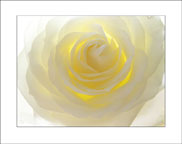Tag Archives: flowers
Pretty in Pastel
Filed under Photography
Spring flowers at Christmas
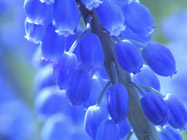 When the days are short and the weather is dull it’s lovely to have some Spring bulbs in the house, blooming and filling the air with their sweet scent to remind us that the warmer weather is really just around the corner. If you’d like some hyacinths in your hallway or daffodils on your dining table for Christmas then now is the time to think about exactly what you’d like to have and how you will display them.
When the days are short and the weather is dull it’s lovely to have some Spring bulbs in the house, blooming and filling the air with their sweet scent to remind us that the warmer weather is really just around the corner. If you’d like some hyacinths in your hallway or daffodils on your dining table for Christmas then now is the time to think about exactly what you’d like to have and how you will display them.
Once you have decided on what flowers you’d like, think about the containers to put them in. Baskets, of all sizes, lined with thick plastic to make them waterproof are the most obvious but any container given a similar treatment would look equally beautiful.
You will need to buy ‘prepared’ bulbs for Christmas flowering – bulbs that have been specially treated to speed up their growth. I’d recommend using commercially prepared bulb fibre for potting, especially for containers where there are no drainage holes. (If you want to use regular potting compost make sure that it is open textured and free draining).
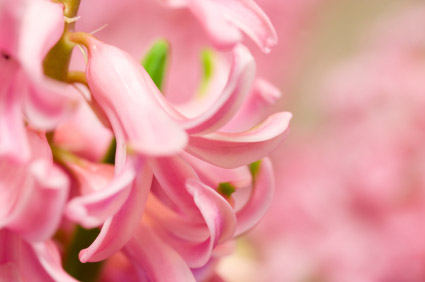 Put some well soaked bulb fibre (or potting compost) into your pot or container, leaving enough space to allow the bulbs to be placed inside with the tips just below the rim of the container. The bulbs can be placed close together but should not be touching. Cover with bulb fibre and water well. The container should then be placed in a cool spot such as a shed, or in a shady corner of the garden. Darkness is not essential but a cool temperature is. Do not put in a black plastic sack as this only encourages mould.
Put some well soaked bulb fibre (or potting compost) into your pot or container, leaving enough space to allow the bulbs to be placed inside with the tips just below the rim of the container. The bulbs can be placed close together but should not be touching. Cover with bulb fibre and water well. The container should then be placed in a cool spot such as a shed, or in a shady corner of the garden. Darkness is not essential but a cool temperature is. Do not put in a black plastic sack as this only encourages mould.
After 10-12 weeks young green shoots should start to appear (these will be paler if the pot has been kept in the dark). When the shoots have reached about 5cm (2 ins) in height, bring the pot into a cool room and they should flower in time for Christmas. Spring flowering bulbs at Christmas, planted in pretty containers, make a lovely gift.
Caution: The bulbs of Daffodil, Hyacinth and Narcissus are poisonous so please practise basic care by washing your hands when you have handled them.
Filed under Christmas Countdown, Gardening
Caramel and White
The hedge at the south end of our garden has been turning brown and dying over this Summer and ‘someone in the know’ yesterday told me that it has honey fungus. This is not good news, not good at all. It is only feet away from a very large, very old and very beautiful rhododendron (which I’ve read are susceptible to honey fungus) and is flanked by two camellias – plants that I really love.
Am I now going to lose the beautiful white camellia that lights up my garden over the dark Winter months? I do hope not.

Camellia blossom ~ new and pure white rubs shoulders with a ‘rusted’ bloom (caused by excessive rain)
Filed under Home, Photography
Natural deterrent to aphids
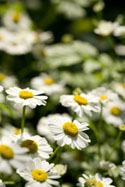 Battling with aphids (greenfly) in the garden? Commercially available insecticides often contain a chemical called pyrethrum which is derived from nature. Rather than buying bottles of commercially prepared and potentially hazardous chemicals, you can harness the power of nature in deterring greenfly just by some clever planting.
Battling with aphids (greenfly) in the garden? Commercially available insecticides often contain a chemical called pyrethrum which is derived from nature. Rather than buying bottles of commercially prepared and potentially hazardous chemicals, you can harness the power of nature in deterring greenfly just by some clever planting.
Feverfew (Tanacetum parthenium) is a pretty daisy-like plant that contains pyrethrins – very similar to the chemicals in commercial sprays. Plant Feverfew amongst your flowers and it’s presence will deter the little insect marauders.  Golden feverfew is a pretty plant in its own right – as the name suggests its foliage is a yellow/golden colour – and all plants will readily self-seed all over the garden if you allow them to. (This plant is also used as a traditional herbal remedy for migraine).
Golden feverfew is a pretty plant in its own right – as the name suggests its foliage is a yellow/golden colour – and all plants will readily self-seed all over the garden if you allow them to. (This plant is also used as a traditional herbal remedy for migraine).
 Whilst it is possible to make your own insecticidal spray or powder from these plants I wouldn’t advise it as it is toxic to bees. In its plant form it seems to work well enough for me and does no harm to bees. Some sources claim that it will deter bees from the garden, although I have never found this to be the case and have often seen bees visiting the feverfew flowers.
Whilst it is possible to make your own insecticidal spray or powder from these plants I wouldn’t advise it as it is toxic to bees. In its plant form it seems to work well enough for me and does no harm to bees. Some sources claim that it will deter bees from the garden, although I have never found this to be the case and have often seen bees visiting the feverfew flowers.
Filed under Gardening, General Health, General tips, Herbal alternatives
The Summer garden: colour and scent
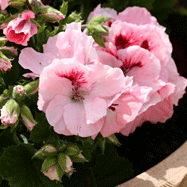 When I moved to my current home I inherited a garden permanently planted with perennial plants that just grow and grow and need little care except for an occasional gentle pruning session. That’s wonderful, but it doesn’t allow me to ring the changes now and again through the use of Summer bedding plants. These plants are mostly regarded and treated as annuals, intended really to last just one season (although some can and do last longer – some of them self-seeding all over your garden if you allow them to). What I love about these Summer plants is that they quickly allow me to be creative with colour in the garden, giving it a different look and feel in much the same way as changing a few accessories in a room will give a fresh new look to a space.
When I moved to my current home I inherited a garden permanently planted with perennial plants that just grow and grow and need little care except for an occasional gentle pruning session. That’s wonderful, but it doesn’t allow me to ring the changes now and again through the use of Summer bedding plants. These plants are mostly regarded and treated as annuals, intended really to last just one season (although some can and do last longer – some of them self-seeding all over your garden if you allow them to). What I love about these Summer plants is that they quickly allow me to be creative with colour in the garden, giving it a different look and feel in much the same way as changing a few accessories in a room will give a fresh new look to a space.
Just recently we created some new borders along the edges of our terrace and now that May has come around I’m really back in my element, practising my exterior design skills, picking colour combinations of bedding plants and planting them out in the borders. This year I’ve gone for a combination of pink and white, with an occasional accent of very, very pale lemon yellow. My reason for picking this pale colour palette was very specific. Our terrace was 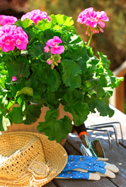 newly created this Spring and I’m anticipating many evenings spent outside, either lingering over dinner or sitting and enjoying the evening over a glass of wine. The colour white, or anything near white will reflect back what little light is still available so that the pale flowers outside will act as tiny beacons at dusk. If you want to be a purist and just work with white alone this can look absolutely stunning, especially when combined with silvery leaved plants against a backdrop of deep greens. If, on the other hand, you’re looking to create the warm atmosphere of a Mediterranean garden then choose flowering plants that fall in the red / pink/ orange range.
newly created this Spring and I’m anticipating many evenings spent outside, either lingering over dinner or sitting and enjoying the evening over a glass of wine. The colour white, or anything near white will reflect back what little light is still available so that the pale flowers outside will act as tiny beacons at dusk. If you want to be a purist and just work with white alone this can look absolutely stunning, especially when combined with silvery leaved plants against a backdrop of deep greens. If, on the other hand, you’re looking to create the warm atmosphere of a Mediterranean garden then choose flowering plants that fall in the red / pink/ orange range.
Another aspect of the garden worth considering is scent. Most Summer bedding plants don’t carry significant scent 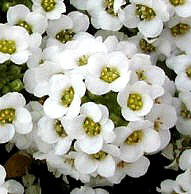 but there are some little superstars that I think are well worth including. Top of the list for me would be the humble alyssum. Its tiny flowers produce the most heavenly honey-sweet scent so it’s no surprise that I’ve included many of them in my Summer planting scheme.
but there are some little superstars that I think are well worth including. Top of the list for me would be the humble alyssum. Its tiny flowers produce the most heavenly honey-sweet scent so it’s no surprise that I’ve included many of them in my Summer planting scheme.
The choice of Summer bedding plants is vast and the fun is in working out your own colour combinations and planting scheme. Go to your local plant nursery, see what is available and take advice from the staff there, always bearing in mind the ultimate height and spread of your chosen plants.
Just for quick reference, here are a few of my favourite Summer bedding plants:
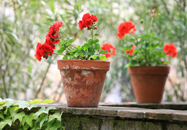 Pelargonium / Geranium – essentially one and the same plant but they do look distinctly different. Pelargoniums, which are susceptible to frost, have beautiful frilly flowers and unusual ‘crinkle-cut’ leaves. Geraniums are sold as both Summer bedding plants and border perennials (plants that flower and/or grow year after year). Some varietes have pretty, variegated (multi-coloured) leaves. Flower colours: white, pink, red and red/orange. Scent: The flowers have no scent but the plant itself has a distinctive and pleasant smell that always reminds me of Summer.
Pelargonium / Geranium – essentially one and the same plant but they do look distinctly different. Pelargoniums, which are susceptible to frost, have beautiful frilly flowers and unusual ‘crinkle-cut’ leaves. Geraniums are sold as both Summer bedding plants and border perennials (plants that flower and/or grow year after year). Some varietes have pretty, variegated (multi-coloured) leaves. Flower colours: white, pink, red and red/orange. Scent: The flowers have no scent but the plant itself has a distinctive and pleasant smell that always reminds me of Summer.
I like these plants because they tend to be very forgiving and don’t mind the heat. You won’t find them wilting at the end of a long hot day and if you forget to water them one day they won’t sulk and wither.
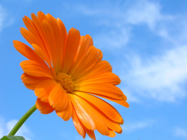 Marigold: Once so common in our gardens but I read recently that they have so declined in popularity that some varietes may disappear entirely. Maybe it’s the colour range that puts people off because they are typically coloured bright orange. In fact other varieties are also available from red/orange in colour through to yellow and even white. (The very pale lemon yellow highlights in my planting scheme this year are from marigolds). Again, they’re fairly robust little plants and have the added advantage that a few flower petals can be used to brighten up Summer salads. I have also read that their presence in the flower border may help to deter certain garden pests. This may be something to do with the distinctive smell of the foliage, which is in some ways is similar to the geranium. Either way, this is also a smell that I associate with long hot Summers.
Marigold: Once so common in our gardens but I read recently that they have so declined in popularity that some varietes may disappear entirely. Maybe it’s the colour range that puts people off because they are typically coloured bright orange. In fact other varieties are also available from red/orange in colour through to yellow and even white. (The very pale lemon yellow highlights in my planting scheme this year are from marigolds). Again, they’re fairly robust little plants and have the added advantage that a few flower petals can be used to brighten up Summer salads. I have also read that their presence in the flower border may help to deter certain garden pests. This may be something to do with the distinctive smell of the foliage, which is in some ways is similar to the geranium. Either way, this is also a smell that I associate with long hot Summers.
Alyssum: Only growing to about 4 inches in height, they are best placed at the front of the border. What they lack in height they more than make up for in scent. ‘Alyssum’ in Greek means ‘against madness’ and though I can’t vouch for that (!) what I can tell you is that the scent of these tiny flowers always, always makes me feel happy. I have traditional white alyssum in my plant border and in pots dotted all over the garden but you may find other varieties available in pale pink, through to biscuit coloured and lemon. This as far as I’m concerned is a ‘must have’ in the garden.
Lobelia: Another plant for the edges of flower borders, this is also very often used in hanging baskets where it forms a cascade of small blue or white flowers. Very pretty – and better still, it attracts butterflies to the garden.
Begonia: There are many varieties of this lovely plant growing to all different sizes. In tropical or sub tropical climates they will go on growing. Here in the UK they are treated as Summer bedding plants and the type I’m specifically referring to here are the miniature variety and often used as useful space fillers in Summer borders and pots. Coming in a variety of flower and leaf colours they grow to no more than about 8 inches in height, have an abundance of flowers with deep yellow centres and healthy, fleshy leaves that make them appear particularly lush.
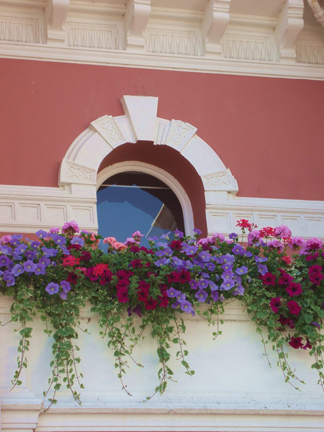
Mistakes
Mistakes are the portals of discovery ~ James Joyce

A montage of various photos which, quite obviously, didn’t turn out as expected! I’ve said before that I hate to throw my photos away and this has led me on more than one occasion to play with them further and produce something which I do like, despite their imperfections. Sometimes you’ve just got to work with what you have in life.
Filed under Photography
Rose Pot Pourri
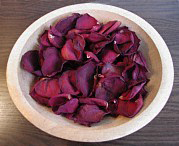 Valentines Day has been and gone and by now those beautiful red roses have begun to fade. It’s a shame to throw them away when they can so easily be dried and used for pot pourri that will last for many, many weeks, if not months ahead.
Valentines Day has been and gone and by now those beautiful red roses have begun to fade. It’s a shame to throw them away when they can so easily be dried and used for pot pourri that will last for many, many weeks, if not months ahead.
The time to turn them into pot pourri is really just as the flower heads start to droop and the petals are dropping away because once removed from the stem, the petals are still colourful and beautiful.
There are a few methods for drying flower petals, two of which require patience, one of which is quick and easy. Here’s the quick and easy method and all it requires is a few pieces of kitchen paper, a microwave and a small bottle of rose essential oil (a scent ‘fixative’ of orris root powder is an optional extra).
Method
Gently separate the petals from the stems and scatter them in a single layer on a microwaveable plate onto which you have placed a piece of kitchen paper. Microwave on a medium setting for 15 seconds, turn the petals and microwave again for another 15 seconds. The petals will become a richer, darker colour but shouldn’t be brittle. I find that I can generally do one bloom at a time like this.
When they’re all done pop them in a plastic bag and scatter with a few drops of rose essential oil, close the top of the bag and gently toss the petals in the bag. Then preferably leave the bag shut for half an hour or so before use. Display in pretty, open containers around the house and top up the scent with more drops of essential oil as and when necessary.
If you want to make the scent last longer, you can add approx. one tablespoon of orris root powder per cup of petals just before you sprinkle on your initial dose of rose oil. Orris root is simply a natural fixative, derived from the root of a species of iris, and can be obtained from many herb supply outlets.
Filed under General house tips, General tips
No words necessary
One of the nice things about taking photos regularly is being able to look back on other years at any given time period. It’s a bit like a visual diary – no words necessary. Last year I became enamoured with Flickr and it gave me all the excuse I needed to start taking photos on a weekly basis. The legacy is many, many files that I’m still struggling to work my way through, deciding which to keep and which to dump – a pruning job that is proving very difficult because I’ve always had trouble throwing photos away. A distinct advantage, however, is the fact that I can look at a photo like the one below and even if today’s weather isn’t too terrific, images from past years will tell me that by now winter is receding. Another three weeks and I can go down to the little valley where I shot the photos below and the beautiful and very old magnolia trees should be in full bloom. As someone who sometimes struggles to stay cheerful during the winter months, this is just the news I need. When I see colourful blossom starting to appear, I know that I can come out of my virtual winter hibernation, better weather is just around the corner.

…………………………………………………………………………………………………………………………..
Please note: All my photos are watermarked and copyrighted and therefore should not to be downloaded, used, copied, reproduced or distributed in any way without my prior consent
Filed under Home, Photography, Smile / Humour
Winter antidote, 1
The snow that everyone seems to get so excited about over here is something I really hate. I tried yesterday to take some pretty photos of the snow covered plants etc. but the truth is, I hate the blandness of it all – they all look bleuch to me. So it’s white….and I should get excited because…? No, no, give me bright colours any day.
I was photographing orchids last week, practising with a new lens I’d been given for Christmas. Now here is something that does make me feel good.

Filed under Photography
Cut flowers
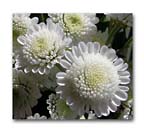 Commercially grown cut flowers are treated after they have been harvested so that they last longer. If you buy from a reputable outlet and follow a few basic rules, there is no reason why you shouldn’t have your flowers for a week or more. Blooms from the garden are beautiful too, but don’t expect them to last as long. In either case, the transient nature of real flowers, I think, adds to their beauty. For me there is something rather sad about the fake versions, no matter how life-like they may look.
Commercially grown cut flowers are treated after they have been harvested so that they last longer. If you buy from a reputable outlet and follow a few basic rules, there is no reason why you shouldn’t have your flowers for a week or more. Blooms from the garden are beautiful too, but don’t expect them to last as long. In either case, the transient nature of real flowers, I think, adds to their beauty. For me there is something rather sad about the fake versions, no matter how life-like they may look.
The flowers: If you’re buying loose cut flowers follow the basic design principle that things tend to look best grouped in odd numbers so buy three, five or seven stems. My favourite flower is the oriental lily and just three stems of this in a simple glass vase looks elegant and beautiful, proving that buying flowers needn’t be overly expensive.
The vase: I tend to prefer glass most of the time – because of its stark simplicity it goes with everything, making the flowers the star attraction. Other containers do, however, work well and here is where you can use your imagination because if an item has at one time contained liquid, then obviously it can be given a second lease of life as a container for flowers. Look for antique or vintage kitchen ware – jugs, teapots, tumblers or even little cups. Old jars, rinsed out and painted with glass paint can look good. If you have children around you could get them to paint a vase for you. Even tin cans can take on a new lease of life. Soak off the labels, clean them thoroughly and make sure there are no raw edges left around the top. Again, group in odd numbers for maximum impact – three shiny tin cans, lined up in a row and filled with cottage-type garden flowers would look very pretty.
Whatever you use, it should be squeaky clean to begin with as bacteria kills flowers.
Preparing the flowers: Cut flowers bought from the shop should ideally be dealt with as soon as you arrive home with them. Unwrap them carefully and trim the stems – take off at least an inch but you can take more if a certain height suits your container better. (In short containers like cups and tumblers flowers tend to look best if the head appears to float at the level of the rim). Cut the stems at a slant using sharp scissors or a knife. I keep a pair of small garden secateurs for this in the kitchen drawer as pre-prepared bunches of flowers often contain flowers with woody stems which play havoc with ordinary scissors.
Remove all leaves that will sit below the water level otherwise they will start to rot, make the water cloudy and bacteria will begin to grow.
Flowers look equally beautiful whether ‘arranged’ or cut roughly to one length. You don’t need to be an expert to make a pretty display. I tend to take pot luck, trimming the stems, individually, to about the same length and slotting them into the vase where I think they look best. About the only bit of advice I’d give is not to make them look too regimented. Keep in mind how they would look in the garden, and let your creative eye be your guide.
Once you have arranged them, fill your vase with lukewarm water into which you have dissolved some commercially prepared flower food – your bunch of flowers should come with a sachet of flower food, either in powder or liquid/gel form. If you’re buying loose stems, make sure that the supplier gives you a sachet.
Positioning flowers in your home to make them last longer: Avoid direct sunlight, heat and draughts. Remove faded flowers as they occur.
Filed under Gardening, General house tips, General tips



